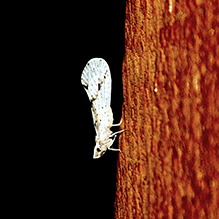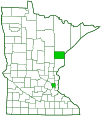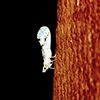Derbid planthopper
(Otiocerus francilloni)
Conservation • Description • Habitat • Ecology • Distribution • Taxonomy
Conservation Status |
|||
| IUCN Red List | not listed |
||
| NatureServe | not listed |
||
| Minnesota | not listed |
||
Description |
Otiocerus francilloni is a small derbid planthopper. It occurs in the United States east of the Great Plains and in southern Ontario Canada. Like all planthoppers in the genus Otiocerus, it is relatively scarce compared to other planthoppers. Adults feed on the foliage of trees and tall shrubs. Little else is known of their life history. Adults are relatively large for derbid planthoppers. The body length is 5⁄16″ (7.5 mm). The body is whitish to pale yellow, not reddish. The head strongly projects forward, resembling a snout or beak when viewed from the side. It is thin when viewed from above. It is mostly pale with cloudy dark markings. The top of the head (vertex) is flat. The junction where it meets the front of the head (frons) is distinctly obtusely angled, not rounded. There are two compound eyes and no simple eyes (ocelli). The antennae are blackish but the basal appendage at the base of each antenna is white. The forewings (hemelytra) are pale and long. They are narrow at the base, becoming much wider toward the tip, giving them a moth-like appearance. Dark spots are scattered over the entire surface, including at the base. Some of the spots are grouped with dark dots to form an indistinct, broken, oblique, band. There are also three blackish spots on the rear margin. On the abdomen, there is a dark spot on each side of all abdominal segments. |
Size |
Body length: 5⁄16″ (7.5 mm) |
Similar Species |
Habitat |
|
Ecology |
Season |
|
Behavior |
|
Life Cycle |
|
Food |
Foliage of trees and tall shrubs |
Distribution |
||
|
Sources |
|
| 8/28/2025 | ||
Occurrence |
||
|
||
Taxonomy |
|
Order |
Hemiptera (True bugs, Hoppers, Aphids, and Allies) |
Suborder |
Auchenorrhyncha (true hoppers) |
Infraorder |
Fulgoromorpha (planthoppers) |
Superfamily |
Fulgoroidea |
Family |
Derbidae (derbid planthoppers) |
Subfamily |
Otiocerinae |
Tribe |
Otiocerini |
Genus |
Otiocerus |
Subordinate Taxa |
|
|
|
Synonyms |
|
|
|
Common Names |
|
This species has no common name. The common name of the family Derbidae is derbid planthoppers, and it is applied here for convenience. |
|
Glossary
Frons
The upper front part of an insect’s face, roughly corresponding to the forehead.
Hemelytron
The forewing of true bugs (Order Hemiptera), thickened at the base and membranous at the tip. Plural: hemelytra.
Ocellus
Simple eye; an eye with a single lens. Plural: ocelli.
vertex
The upper surface of an insect’s head.
Visitor Photos |
Share your photo of this insect. |
||
This button not working for you? |
||
Gary Walton |
 |
Otiocerus francilloni is a planthopper but differs from other planthoppers in that it feeds on fungi in rotted wood during the early stages of its development rather than the sap of vascular plants. I have not seen this species since my sighting in 2018. |
MinnesotaSeasons.com Photos |
|

Slideshows |
|

Visitor Videos |
Share your video of this insect. |
||
This button not working for you? |
||
|
Other Videos |
|

Visitor Sightings |
Report a sighting of this insect. |
||
This button not working for you? |
||
MinnesotaSeasons.com Sightings |
|

|
Created: 8/28/2025 Last Updated: © MinnesotaSeasons.com. All rights reserved. |

